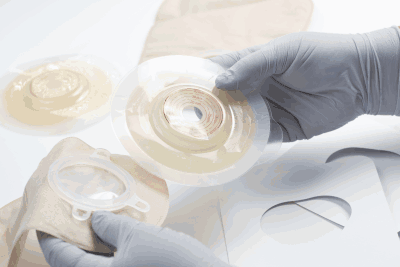|
Individualize Product Selection: Living with Your Ostomy
•PMH/PSH
•Sensory
and manual dexterity
•Education/Cognition
•Occupation
•Finances
•Living
arrangements
•Social
support
•Pain
•Recreation/Activity
tolerance
•Nutrition/hydration
A comprehensive assessment should include both the patient and their stoma. Both are essential in order to maximize their self-care skills and confidence in adjusting to their new life with an ostomy. No one size, type or brand of appliance will fit everyone. As with any patient, a thorough assessment must be made prior to ostomy surgery. The assessment should be done with the knowledge of why the patient needs ostomy surgery (Cancer—that could require additional treatment--or Inflammatory Bowel Disease where the removal of the diseased colon will alleviate the need for further medical treatment). Pertinent past medical history or (PMH) and past surgical history or (PSH) is also important, as are the patient’s education level, level of cognition, and their mental status. Also, their occupation can play a significant role in their ability to successfully live with an ostomy. Other considerations should include financial and insurance resources, as well as a physical assessment of the patient that includes checking their vision, hearing, and manual dexterity for any potential issues. Some of the assessment should also include personal factors such as whether they have any social support at home, and what their access to toilet facilities are like at work and home. Whether they have pain or an activity tolerance can influence decisions regarding product selection. Their prior recreational activities are also helpful to know (for instance, a patient in their 70’s with a new ileostomy may have been attending water aerobics classes four days per week for the past ten years—and will probably want to continue). This needs to be taken into consideration. And, of course, their nutrition and hydration status, and current height and weight versus optimal.
There are several assessment considerations for stomas including the following: The stoma’s type (large bowel/ small bowel) (end, loop or double-barrel), and its location on the abdomen--for instance, right lower quadrant or left lower quadrant. The size, shape and height of stoma. The location of the stoma lumen (straight up or on the side). And the effluent: is it urine or stool, in what amounts, what consistency, and is there any recognizable timing as to when it becomes more “active”. Also consider the peristomal skin condition: is it intact or impaired? And the characteristics of the abdomen: are there old scars, surgical incisions, dimpling, skin folds or flabbiness? And when the patient sits, stands or lays down, is there any change in the way the stoma looks—or its position?
Medicare Coverage Amounts Examples per month
•Ostomy
pouch, drainable 2 piece - 20
•Ostomy
skin barrier with flange - 20
•Closed
end bag - 60
•Ostomy
Belt - 1/month
•Paste
- 2
•Overnight
drainage bag - 2
(quantities in excess of guideline needs to be explained
in writing to the fiscal intermediary)
|



